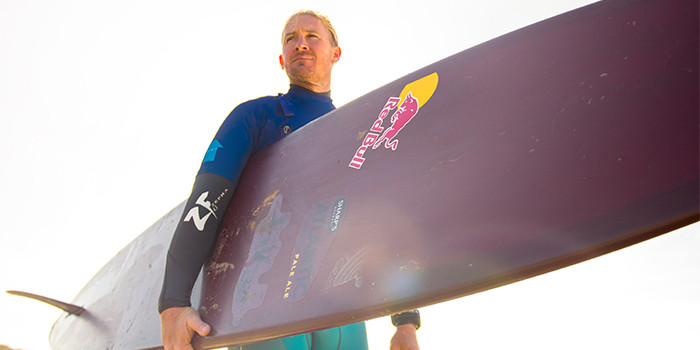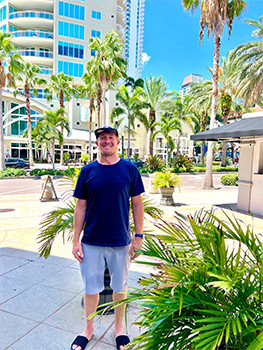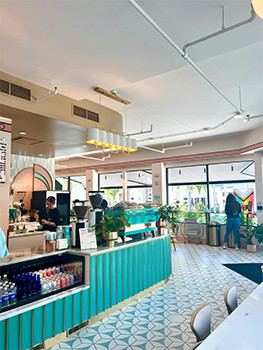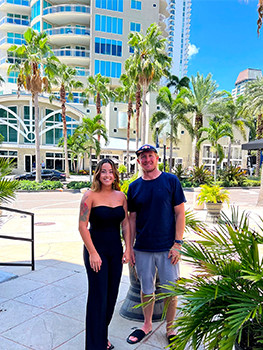Jumby Bay Island Grill
- 561-630-2030
- email us
- Jupiter, Florida, United States

ST. PETERSBURG, FL – July 21, 2022 – InFlorida sat down for a morning sip with big wave surfer Andrew Cotton and his partner Justine at Paradeco Coffee Roasters in Downtown St. Petersburg, FL. We talked about his feature in the HBO Max Documentary 100 Foot Wave and all things big waves!
1. Did you think the 100 Foot Wave would be such a big hit?
To be honest, I didn't really have any idea. We were always filming for Garrett's movie, which I thought would be a 90 minute documentary sort of thing. I didn't know how much I'd be featured or not. And then it was Garrett and his wife and sort of ended up getting a few connections and then it turned into what it is. I found out post-production how much I was featured. I started to get quite a bit of messages and my following started to rise.
2. Are you currently filming for the next series or have you wrapped up?
Yeah. They've shot another series. So, we finished filming Season One in 2019. We've been filming for the last two years. Season Two, I think there's gonna be a lot of different characters in it. Again, I've got no idea how much I’ll be featured in it. I guess I’ll find out with everyone else when it comes out.
3. What did you do before you became a professional big wave surfer?
I’ve always surfed and I’ve always said the dream was to be a professional surfer, but I did loads of different jobs. I've worked in the surf industry for years, and then sort of pretty much got to that stage where I just needed a bit more security and a bit more money. I trained as a plumber in my mid 20s. I worked as a plumber until I was about 30 and I hated it so much. I think actually doing that and working that job just made me realize “I don’t want to do this”. I like big waves and I’ve already done a few seasons in Hawaii, but I never thought I’d be professional. I just thought I could do what I like. I trained as a lifeguard, so I was working seasonal work as a lifeguard and surfing as well.

4. What does your average day look like now? We see that you travel a lot.
It really depends on the season and you know, the big wave season for Europe, which is in the northern hemisphere is October through to March-April. Then, I’m usually based in Portugal. Life is very much dictated by swells and storms. I’m always around the ocean.

5. Do you have a home-base where you settle for a while or are you just constantly chasing the waves?
The two main places I go are Nazare in Portugal and North Devon where I grew up, so I’d say that’s home-base and we spend a lot of time there, months. It’s a seaside town with beaches, not as warm as here in Florida.
6. When you are not surfing the big waves, what do you do for fun? I’d assume you’re a thrill seeker if you’re catching these big waves.
Surfing is what I love to do. When I’m not surfing, I like swimming and other water sports. I’m not really a thrill seeker, I don’t like those risks. Recently, we started snowboarding because Justine comes from the snow. I was kind of worried about breaking my arm or hurting myself, especially if the swell of the year happens or the swell of the decade, and I’m injured.
7. You broke your back catching a big wave before. What was that like?
It was quite painful. It was heavily publicized and made the news. The recovery took a lot of time, but it’s just like anything, if you are doing anything continuously and it’s risky, like any sport, you have a chance of getting injured.
8. When you're on a big wave like that, obviously you get towed in on it. How many people are on land watching out in case something like that happens?
In your team, you’ll usually have one or two safety spotters, but when it goes down and something has actually happens, you pretty much rely on your two guys. It’s not like you can just blow a whistle and everyone stops, it’s mother nature. So, anything can happen to essentially anyone, they’re in danger coming out, so it can be risky.
9. Do you remember your first big wave?
Well, this is a really interesting thing like, what is a big wave? When I started surfing, a wave the size of this table, two feet, was massive. It’s personal to the surfer and I think that’s pretty cool. 100 ft. is all in perspective isn’t it? You don’t just go surfing UK waves the size of a table to a 100 ft. wave, it takes time.
10. How has your time in St. Petersburg been and what have you been up to?
It’s been good! We’ve been getting on the water every day. Justine drives the boat and I ride the wake which has been really cool. We saw a lot of wildlife and went to some nature preserves. I’ve also been biking a bit. One of my sponsors and friend Sully lives here. He’s the CEO of MontKush and he’s a biker and an athlete. I’m also here to give a talk to the CEO Council of Tampa Bay before I head out.
11. How did Covid affect surfing for you?
I couldn’t travel. I noticed that the waves were quieter, too. I was able to travel to Portugal to make sure I wasn’t stuck anywhere else, and to make sure I was stuck where I needed to be, where the waves were.

It was a pleasure getting to learn about the ins and outs of the big wave surf world. The InFlorida Team is ready to give surfing a try as Andrew told us, it’s never too late to get on the board.
Catch Andrew Cotton conquering big waves in the Emmy Nominated HBO Max Documentary: 100 ft. Wave and stay tuned for the second series!